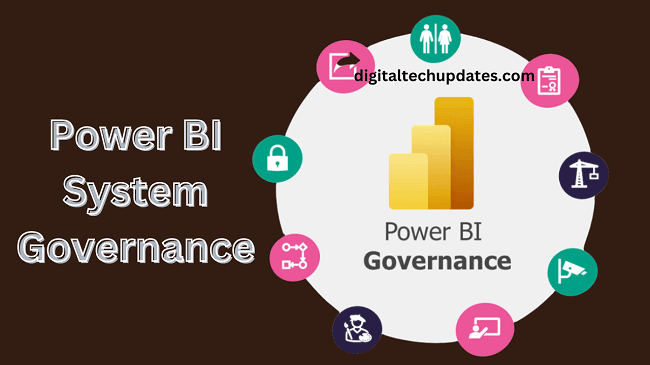Organizations extensively rely on business intelligence (BI) technologies like Power BI in today’s data-driven world to make wise decisions and uncover insightful information from their data. Users may build interactive reports and dashboards with Power BI, a potent Microsoft tool that turns raw data into useful information. But immense power also entails great responsibility. Unrestricted data consumption and access can result in a number of problems, including inaccurate reporting, resource misallocation, and data security breaches.
Implementing a solid Power BI governance framework is crucial to overcoming these obstacles. Today we will look at the significance of Power BI governance and offer insightful advice on how to develop a successful Power BI governance.
What is Power BI Governance?
The term “Power BI governance” refers to the collection of rules, procedures, and regulations that control how Power BI resources are used, managed, and secured inside an organization. Power BI is utilized effectively, safely, and in accordance with the organization’s objectives and data governance regulations thanks to a well-structured governance framework. It facilitates a regulated and structured BI environment by establishing a clear knowledge of roles, responsibilities, and data access privileges.
The Importance of Power BI Governance
1. Data Security
Data security is one of the main issues for every company. Power BI governance ensures that only authorized workers may view and alter critical data, preventing unauthorized access to it. This is essential for preserving data integrity and protecting against any breaches. With the Power BI governance plan by EPC, organizations can effectively address this challenge and establish a robust security framework. It enforces strict access controls and permissions, ensuring that only authorized workers can view, modify, or interact with critical data. By setting granular access levels, sensitive information is safeguarded from unauthorized access and potential data breaches. This preventive approach is crucial for preserving data integrity and protecting against any unauthorized attempts to compromise sensitive information.
2. Consistency and Standardization
Users using Power BI may produce various iterations of the same report or employ inconsistent naming standards if there is no governance. A governance framework aids in enforcing standardization among reports and dashboards, fostering a unified and simple-to-understand BI environment.
3. Resource Optimization
Unchecked Power BI use might put a load on system resources and cause performance problems. Organizations can optimize resource allocation via governance, ensuring that reports are handled effectively and users have a positive experience.
4. Compliance and Regulatory Requirements
Strict regulatory requirements for data processing and security apply to many companies. By ensuring that the firm complies with these rules, a strong governance strategy lowers the danger of legal repercussions. To support this, companies hire Imenso’s Power BI consultants through expert Microsoft Power BI consulting which can help establish robust data governance practices tailored to these regulations.
Creating a Power BI Governance Plan by EPC
Step 1: Define Governance Objectives
Start by stating the goals of your Power BI governance plan in explicit terms. Recognize your organization’s weaknesses and the crucial areas where governance is required. Think about things like report lifecycles, user roles, compliance, data security, and resource efficiency.
Step 2: Identify Stakeholders and Roles
Find out who the main stakeholders are in the Power BI ecosystem. Executives, data analysts, report writers, and IT administrators may all fall under this category. Specify in the governance plan who has access to the data, is responsible for producing reports, publishing dashboards, and managing the infrastructure.
Step 3: Establish Data Access Controls
Controls on data access are the foundation of every governance strategy. Establish data access levels based on user responsibilities to make sure that only authorized people may access sensitive data. For increased security, implement row-level security and connect Power BI to your current authentication platforms.
Step 4: Implement Version Control
Implement version control techniques for reports and dashboards to preserve consistency and prevent version conflicts. Users will always have access to the most recent and authorized versions of reports thanks to this.
Step 5: Set Refresh Schedules
Regular data updates are frequently used in Power BI reports. Create data refresh schedules based on the importance of the data and how often it is updated. This minimizes resource use and stops pointless data refreshes.
Step 6: Define Naming Conventions and Standards
The naming standards for reports, dashboards, datasets, and other Power BI resources should be clear and succinct. In the BI environment, consistent naming promotes orderliness by making it simpler for users to find the appropriate reports.
Step 7: Monitor and Audit
Keep an eye on the security, performance, and use of Power BI. Implement auditing tools to keep track of report and dataset modifications, and conduct routine audits to make sure the governance strategy is being followed.
For organizations to fully utilize this formidable BI technology while guaranteeing data security, compliance, and effective resource management, a solid Power BI governance strategy by EPC is essential. Organizations may develop a well-structured BI environment that fosters consistency, cooperation, and data-driven decision-making by clearly defining objectives, roles, data access rules, and standards.
Power BI governance should be ongoing and adapt to the organization’s changing demands as well as the BI landscape. A well-executed governance strategy will continue to be a crucial component of efficient BI administration and consumption as long as businesses continue to rely on data for their success.



